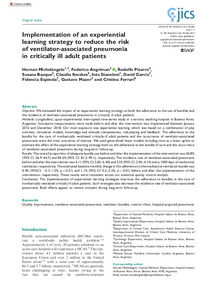Por favor, use este identificador para citar o enlazar este ítem:
https://repositorio.uca.edu.ar/handle/123456789/9810| Campo DC | Valor | Lengua/Idioma |
|---|---|---|
| dc.contributor.author | Michelángelo, Hernán | es |
| dc.contributor.author | Angriman, Federico | es |
| dc.contributor.author | Pizarro, Rodolfo | es |
| dc.contributor.author | Bauque, Susana | es |
| dc.contributor.author | Kecskes, Claudia | es |
| dc.contributor.author | Staneloni, inés | es |
| dc.contributor.author | García, David | es |
| dc.contributor.author | Espínola, Fidencia | es |
| dc.contributor.author | Mazer, Gustavo | es |
| dc.contributor.author | Ferrari, Cristina | es |
| dc.date.accessioned | 2020-04-27T20:29:49Z | - |
| dc.date.available | 2020-04-27T20:29:49Z | - |
| dc.date.issued | 2019 | - |
| dc.identifier.citation | Michelángelo, H., et al. Implementation of an experiential learning strategy to reduce the risk of ventilator-associated pneumonia in critically ill adult patients [en línea]. Journal of the Intensive Care Society. 2019. doi:10.1177/1751143719887285 Disponible en: https://repositorio.uca.edu.ar/handle/123456789/9810 | es |
| dc.identifier.issn | 1751-1437 | - |
| dc.identifier.uri | https://repositorio.uca.edu.ar/handle/123456789/9810 | - |
| dc.description.abstract | Abstract: Objective: We evaluated the impact of an experiential learning strategy on both the adherence to the use of bundles and the incidence of ventilator-associated pneumonia in critically ill adult patients. Methods: Longitudinal, quasi-experimental interrupted time-series study in a tertiary teaching hospital in Buenos Aires, Argentina. Successive measurements were made before and after the intervention was implemented between January 2016 and December 2018. Our main exposure was experiential learning, which was based on a combination of play activities, simulation models, knowledge and attitude competencies, role-playing and feedback. The adherence to the bundle for the care of mechanically ventilated critically-ill adult patients and the occurrence of ventilator-associated pneumonia were the main outcomes of interest. We used generalized linear models including time as a linear spline to estimate the effect of the experiential learning strategy both on the adherence to the bundle of care and the occurrence of ventilator-associated pneumonia during long-term follow-up. Results: The overall proportion of adequate bundle use before and after the implementation of the intervention was 60.8% (95% CI: 56.9–64.7) and 85.6% (95% CI: 81.2–90.1), respectively. The incidence rate of ventilator-associated pneumonia before and after the intervention was 6.11 (95% CI: 5.82–6.40) and 3.55 (95% CI: 2.96–4.14) every 1000 days of mechanical ventilation, respectively. The estimated baseline monthly change in the adherence to the mechanical ventilation bundle was 0.4% (95%CI: 0.3–1.2%, p ¼ 0.31) and 1.1% (95% CI: 0.2–2.2%, p < 0.01) before and after the implementation of the intervention, respectively. These results were consistent across our statistical quality control analysis. Conclusions: The implementation of experiential learning strategies improves the adherence to bundles in the care of mechanically ventilated critically ill adult patients. Such strategies also decrease the incidence rate of ventilator-associated pneumonia. Both effects appear to remain constant during long-term follow-up. | es |
| dc.format | application/pdf | es |
| dc.language.iso | eng | es |
| dc.publisher | SAGE Publications | es |
| dc.rights | Acceso abierto | * |
| dc.rights.uri | http://creativecommons.org/licenses/by-nc-sa/4.0/ | * |
| dc.source | Journal of the Intensive Care Society. 2019 | es |
| dc.subject | ENSEÑANZA DE LA MEDICINA | es |
| dc.subject | VENTILACION MECANICA | es |
| dc.subject | INFECCION HOSPITALARIA | es |
| dc.subject | RESPIRACION ARTIFICIAL | es |
| dc.title | Implementation of an experiential learning strategy to reduce the risk of ventilator-associated pneumonia in critically ill adult patients | es |
| dc.type | Artículo | es |
| dc.identifier.doi | 10.1177/1751143719887285 | - |
| uca.disciplina | MEDICINA | es |
| uca.issnrd | 1 | es |
| uca.affiliation | Fil: Michelángelo, Hernán. Hospital Italiano de Buenos Aires. Departamento de Medicina Interna; Argentina | es |
| uca.affiliation | Fil: Michelángelo, Hernán. Hospital Italiano de Buenos Aires. Departamento de Calidad; Argentina | es |
| uca.affiliation | Fil: Angriman, Federico. University of Toronto. Interdepartmental Division of Critical Care Medicine. Department of Critical Care, Sunnybrook Health Sciences Center; Canadá | es |
| uca.affiliation | Fil: Pizarro, Rodolfo. Hospital Italiano de Buenos Aires. Departamento de Cardiología; Argentina | es |
| uca.affiliation | Fil: Bauque, Susana. Hospital Italiano de Buenos Aires. Departamento de Cuidados Intensivos; Argentina | es |
| uca.affiliation | Fil: Kecskes, Claudia. Hospital Italiano de Buenos Aires. Departamento de Cuidados Intensivos; Argentina | es |
| uca.affiliation | Fil: Staneloni, inés. Hospital Italiano de Buenos Aires. Departamento de Medicina Interna; Argentina | es |
| uca.affiliation | Fil: García, David. Hospital Italiano de Buenos Aires. Departamento de Calidad; Argentina | es |
| uca.affiliation | Fil: Espínola, Fidencia. Hospital Italiano de Buenos Aires. Departamento de Calidad; Argentina | es |
| uca.affiliation | Fil: Mazer, Gustavo. Hospital Italiano de Buenos Aires. Departamento de Calidad; Argentina | es |
| uca.affiliation | Fil: Ferrari, Cristina. Pontificia Universidad Católica Argentina. Facultad de Ciencias Médicas; Argentina | es |
| uca.version | publishedVersion | es |
| item.grantfulltext | open | - |
| item.fulltext | With Fulltext | - |
| item.languageiso639-1 | en | - |
| Aparece en las colecciones: | Artículos | |
Ficheros en este ítem:
| Fichero | Descripción | Tamaño | Formato | |
|---|---|---|---|---|
| implementation-experiential-learning-strategy.pdf | 294,89 kB | Adobe PDF |  Visualizar/Abrir |
Visualizaciones de página(s)
371
comprobado en 24-dic-2025
Descarga(s)
230
comprobado en 24-dic-2025
Google ScholarTM
Ver en Google Scholar
Altmetric
Altmetric
Este ítem está sujeto a una Licencia Creative Commons

